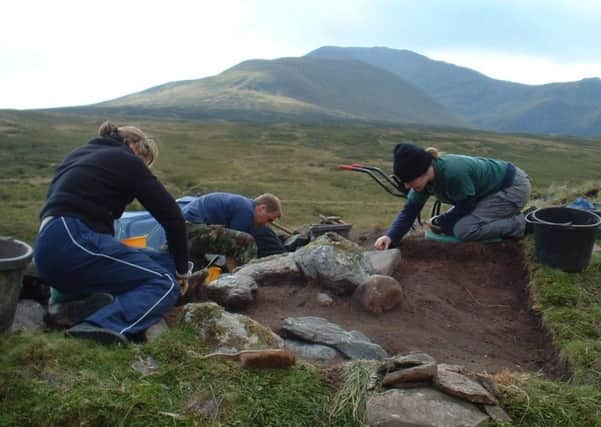Perthshire hills were inhabited in the Stone Age, archaeological diggers reveal


Archaeologists working on Ben Lawers have uncovered evidence of human activities dating back 9,000 years to the Stone Age – and virtually every period since.
Relics unearthed include everything from standing stones, burial cairns and prehistoric flint tools to the remains of Iron Age settlements, ruined Jacobite-era croft houses and even brass-rimmed spectacles.
Advertisement
Hide AdAdvertisement
Hide AdFinds show that what now appears an empty landscape once thronged with human activity, with thousands of people living in the area in times gone by.
The study is the culmination of two decades of excavations and research at the National Trust for Scotland nature reserve around Ben Lawers, on the north shores of Loch Tay in Perthshire.
The study is a uniquely detailed examination of a previously unexplored upland area that is characteristic of much of the central Highlands.
It tells the story of human interaction and occupation from prehistoric times to the recent past, with a particular focus on the last millennium.
The findings reveal that cultivation was carried out much higher in upland areas than previously thought, with trees felled to clear land at an early stage.
Derek Alexander, head of archaeology for the National Trust for Scotland, worked on the Ben Lawers Historic Landscape Project, which is free to download.
He said: “The earliest evidence we found at Ben Lawers was from the Mesolithic period, when people weren’t even farming, they were hunter-gatherers.They were out in the landscape, taking advantage of good places to settle for a period of time, before moving on to make the most of seasonal resources.
“There is a whole series of shielings from medieval times onwards. Underneath these we found traces of fires and pieces of flint and quartz. Radiocarbon dating came back at 7,000 BC.
Advertisement
Hide AdAdvertisement
Hide Ad“We reckon it was a sort of temporary campsite, where people might go to hunt. They would perhaps have chased deer across the hills and trapped them at the pinch points and gullies, which would have made it a bit easier to hit them with arrows or by throwing a spear.
“Very few sites like this have been found in Scotland. We are finding more of them the more we look, but we don’t look very often.
“Excavations tend to happen only where there is a threat – in advance of housing developments, roads being built and that sort of thing. Obviously that’s not really happening in the highest parts of Scotland, but when we do dig we’re finding stuff.”
Lead author of the report Dr John Atkinson, director of Guard Archaeology, said: “The Ben Lawers Project was one of the largest-ranging archaeological research projects ever attempted in Scotland. As such, the results provide a body of reference material for all historic periods that will stand the test of time and create a staging post for future researchers.”